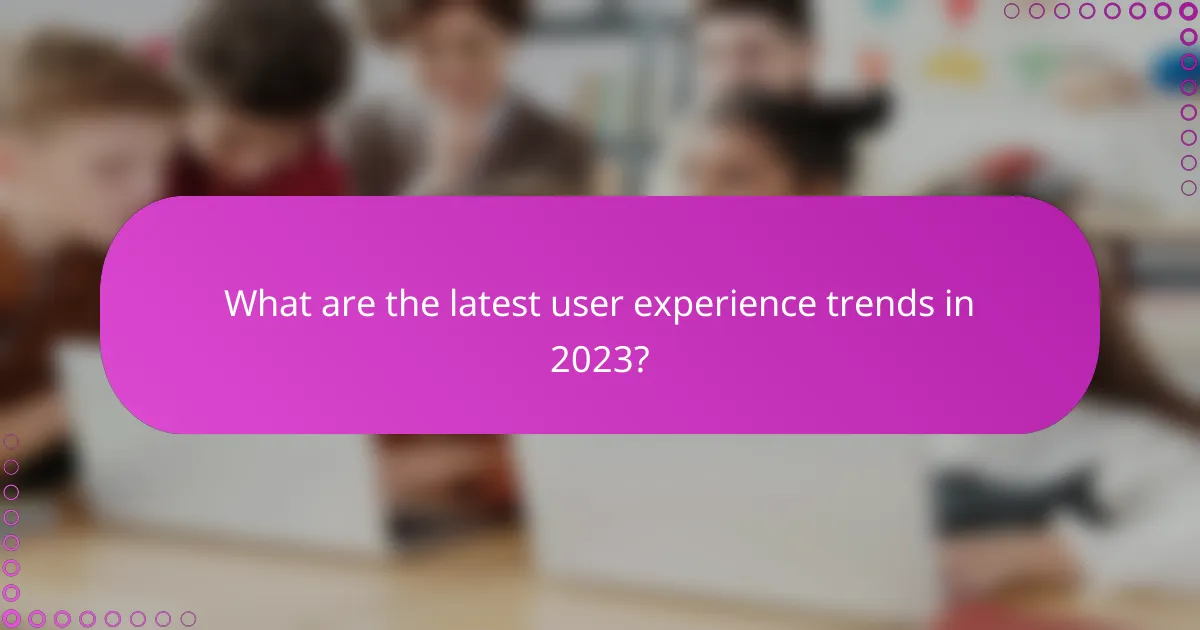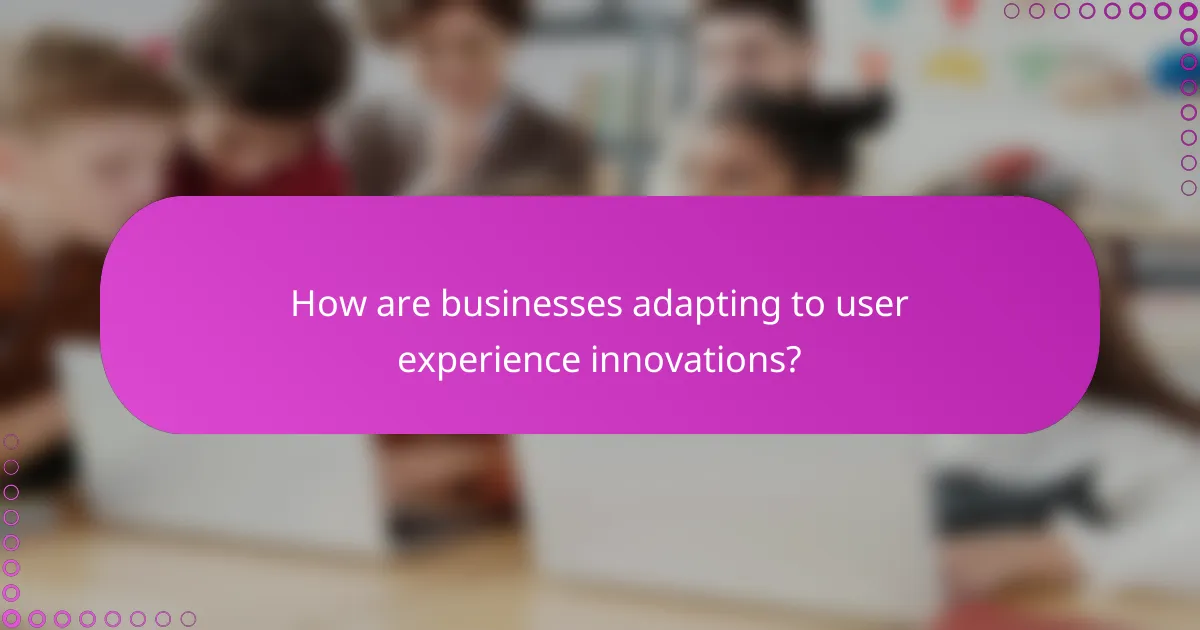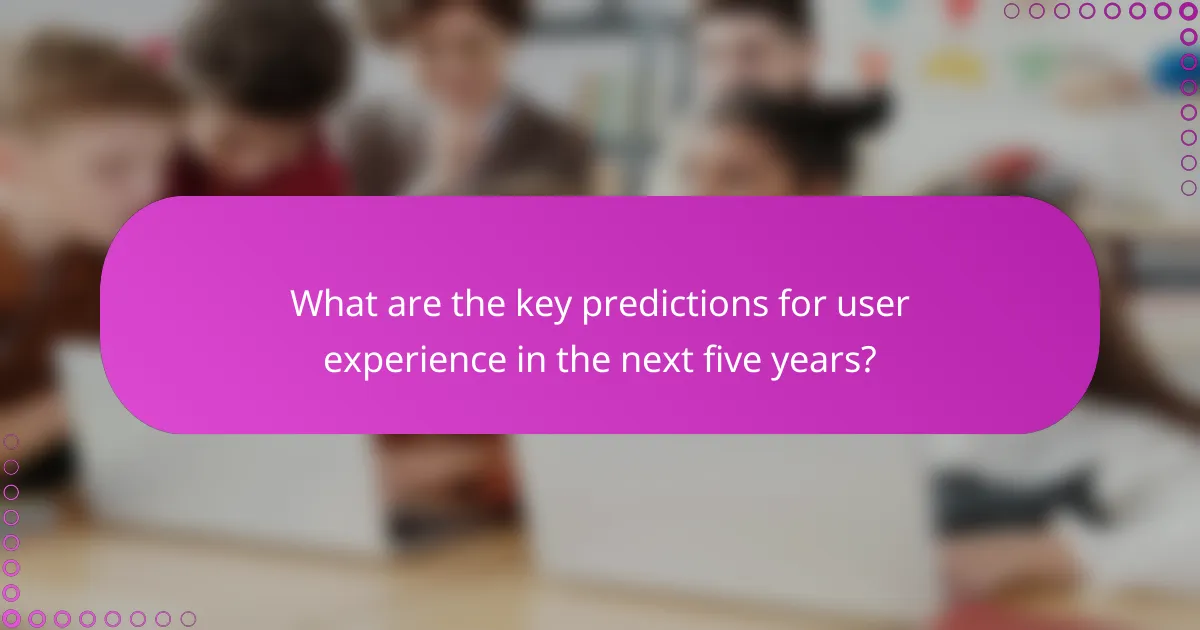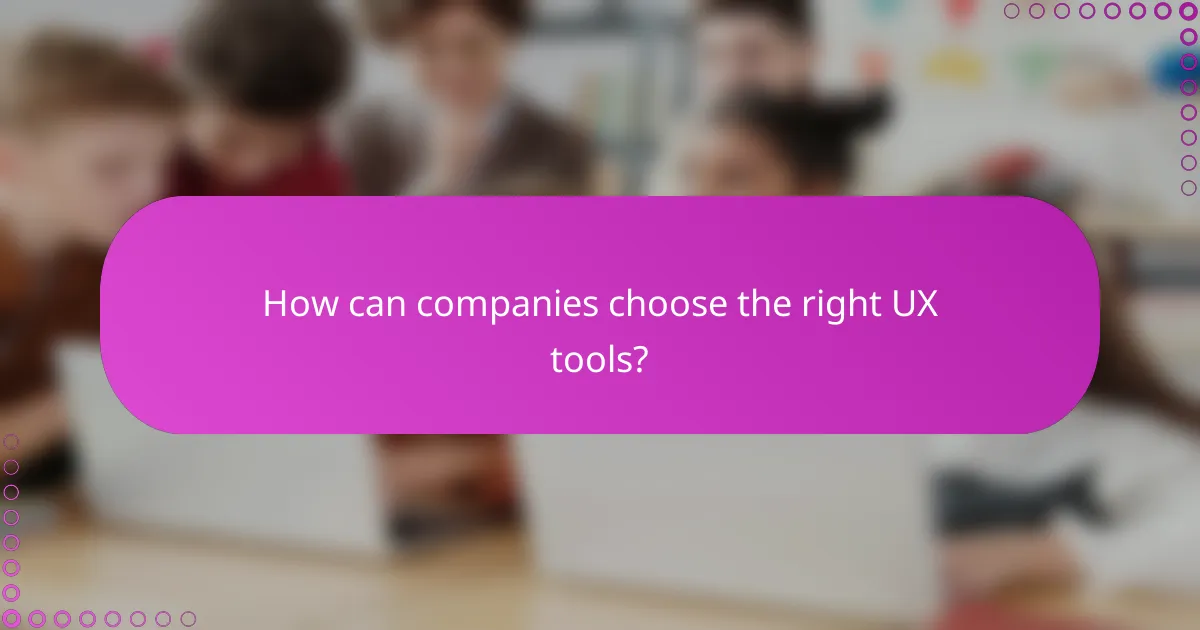User experience trends in 2023 highlight the importance of personalization, voice interfaces, and augmented reality, all designed to boost user engagement and satisfaction. As businesses increasingly leverage user feedback and data analytics, they are better equipped to meet customer expectations and remain competitive. Looking ahead, the next five years will see a focus on accessibility and immersive technologies, transforming how users interact with digital products.

What are the latest user experience trends in 2023?
In 2023, user experience trends emphasize personalization, voice interfaces, augmented reality, micro-interactions, and dark mode preferences. These innovations aim to enhance user engagement and satisfaction across digital platforms.
Personalization through AI
Personalization through AI tailors user experiences based on individual preferences and behaviors. By analyzing data, AI can recommend products, content, or services that align with users’ interests, significantly improving engagement.
For effective personalization, businesses should focus on collecting relevant user data while ensuring privacy compliance. Implementing machine learning algorithms can help refine recommendations over time, leading to a more customized experience.
Voice user interface adoption
Voice user interfaces (VUIs) are increasingly adopted as they provide hands-free interaction and convenience. Users can engage with devices using natural language, making it easier to access information and perform tasks quickly.
To successfully implement VUIs, companies should prioritize clear voice recognition and intuitive command structures. Testing with diverse accents and speech patterns can enhance accessibility and user satisfaction.
Augmented reality integration
Augmented reality (AR) integration enriches user experiences by overlaying digital information in the real world. This technology is particularly effective in retail, allowing customers to visualize products in their environment before making a purchase.
Businesses should consider the technical requirements for AR applications, such as device compatibility and user interface design. Providing clear instructions and ensuring a seamless experience can significantly enhance user engagement with AR features.
Micro-interactions enhancement
Micro-interactions are small design elements that provide feedback and guide users during their interactions. Enhancing these elements can make digital experiences more intuitive and enjoyable, such as animations when a button is clicked or notifications for completed tasks.
To improve micro-interactions, focus on subtle animations and clear cues that inform users without overwhelming them. Testing different designs can help identify which interactions resonate best with your audience.
Dark mode preferences
Dark mode preferences have gained popularity as users seek visually comfortable options that reduce eye strain. Many applications now offer dark mode settings, allowing users to switch based on their environment or personal preference.
When implementing dark mode, ensure that color contrasts are sufficient for readability. Providing users with the option to toggle between modes can enhance accessibility and overall satisfaction with the interface.

How are businesses adapting to user experience innovations?
Businesses are increasingly adopting user experience innovations by integrating user feedback and leveraging data analytics. These strategies help companies enhance their offerings, meet customer expectations, and stay competitive in a rapidly evolving market.
Implementing user feedback loops
User feedback loops involve systematically collecting and analyzing customer insights to inform design and functionality improvements. This approach allows businesses to identify pain points and areas for enhancement, ensuring that products align with user needs.
To effectively implement feedback loops, companies can use surveys, focus groups, and usability testing. Regularly engaging with users can lead to actionable insights that drive continuous improvement and foster customer loyalty.
Utilizing data analytics for UX improvements
Data analytics plays a crucial role in refining user experience by providing insights into user behavior and preferences. By analyzing metrics such as page load times, click-through rates, and user engagement, businesses can make informed decisions to enhance their digital interfaces.
Organizations should focus on key performance indicators (KPIs) that matter most to their users. For instance, tracking user retention rates and task completion times can reveal significant opportunities for UX enhancements. Employing tools like Google Analytics or heatmap software can facilitate this process, helping businesses adapt quickly to user needs.

What are the key predictions for user experience in the next five years?
In the next five years, user experience (UX) is expected to prioritize accessibility, immersive technologies, and the integration of Internet of Things (IoT) devices. These trends will shape how users interact with digital products, making experiences more inclusive, engaging, and interconnected.
Increased focus on accessibility
Accessibility will become a central theme in user experience design, ensuring that digital products are usable by people with varying abilities. This includes adhering to standards such as the Web Content Accessibility Guidelines (WCAG) to create interfaces that are navigable for individuals with disabilities.
Designers will need to consider elements like color contrast, keyboard navigation, and screen reader compatibility. For example, using high-contrast colors and providing text alternatives for images can significantly enhance usability for visually impaired users.
Expansion of immersive experiences
Immersive experiences, such as virtual reality (VR) and augmented reality (AR), will gain traction in user experience design. These technologies allow users to engage with content in a more interactive and engaging manner, enhancing the overall experience.
Brands will increasingly leverage AR for applications like virtual try-ons or interactive product demonstrations. For instance, furniture retailers may use AR to let customers visualize how a piece of furniture fits in their home before making a purchase.
Greater integration of IoT devices
The integration of IoT devices into user experience will streamline interactions across various platforms. As more devices become interconnected, users will expect seamless experiences that allow them to control multiple devices from a single interface.
For example, smart home systems will enable users to manage lighting, temperature, and security through a unified app, enhancing convenience and efficiency. Designers must focus on creating intuitive interfaces that simplify these interactions, ensuring that users can easily navigate their connected environments.

How can companies choose the right UX tools?
Companies can choose the right UX tools by carefully assessing their specific user needs and the functionalities offered by various tools. This process involves understanding the goals of the project and matching them with the capabilities of the tools available in the market.
Evaluating user needs and goals
To effectively evaluate user needs and goals, companies should start by conducting user research, such as surveys or interviews, to gather insights about their target audience. This helps in identifying pain points, preferences, and expectations that the UX tools must address.
Additionally, companies should define clear objectives for their UX projects, such as improving user engagement or increasing conversion rates. This clarity will guide the selection of tools that align with these specific goals, ensuring that the chosen solutions are relevant and effective.
Comparing tool functionalities
When comparing tool functionalities, companies should create a checklist of essential features that their projects require, such as prototyping capabilities, collaboration tools, or analytics integration. This allows for a systematic evaluation of different UX tools based on how well they meet these criteria.
It’s also beneficial to consider the ease of use and learning curve associated with each tool. For instance, some tools may offer advanced features but require extensive training, while others may be more user-friendly but lack certain functionalities. Balancing these factors will help companies make informed decisions that suit their team’s skills and project needs.

What are the benefits of adopting user experience innovations?
Adopting user experience innovations leads to significant advantages, including enhanced customer engagement and loyalty. These improvements can result in measurable business outcomes, such as increased sales and brand reputation.
Improved customer satisfaction
Innovations in user experience directly contribute to improved customer satisfaction by making interactions more intuitive and enjoyable. For instance, streamlined navigation and personalized content can help users find what they need quickly, reducing frustration.
To achieve this, businesses should regularly gather user feedback and analyze behavior patterns. Implementing changes based on this data can lead to a more tailored experience that resonates with customers.
Higher conversion rates
Higher conversion rates are often a direct result of effective user experience innovations. By simplifying the purchasing process and minimizing obstacles, businesses can encourage users to complete transactions more frequently.
Key strategies include optimizing website load times and ensuring mobile compatibility. For example, a responsive design can significantly enhance user engagement on smartphones, leading to increased conversions. Regular A/B testing can also help identify which elements drive the best results.

What are the challenges in implementing new UX trends?
Implementing new UX trends presents several challenges, including resource allocation, budgeting, and keeping pace with user expectations. Organizations must navigate these hurdles to effectively enhance user experiences while maintaining operational efficiency.
Resource allocation and budgeting
Resource allocation and budgeting are critical when adopting new UX trends. Companies need to determine how much time, money, and personnel they can dedicate to UX initiatives without jeopardizing other projects. A common approach is to allocate a percentage of the overall budget specifically for UX improvements, often ranging from 5% to 15% of total project costs.
When budgeting for UX, consider both direct costs, such as hiring specialized designers or purchasing software tools, and indirect costs, like training existing staff. Prioritizing high-impact projects can help maximize the return on investment. Regularly reviewing and adjusting the budget based on project outcomes ensures resources are effectively utilized.
To avoid common pitfalls, establish clear metrics for success and maintain open communication among stakeholders. This transparency helps justify expenditures and fosters a collaborative environment for implementing new UX trends.










